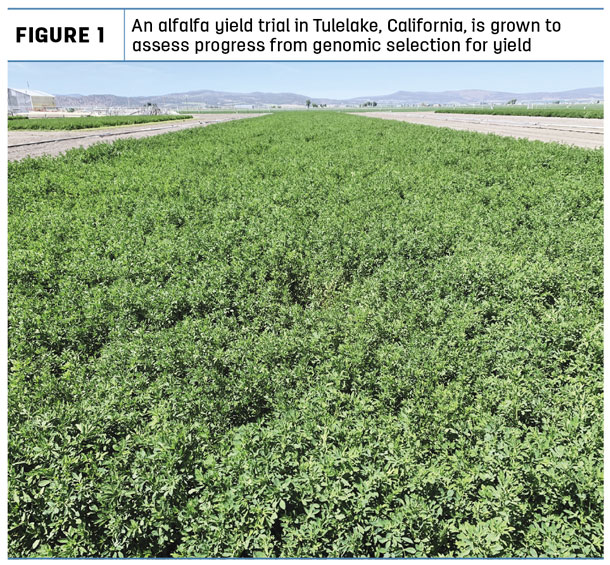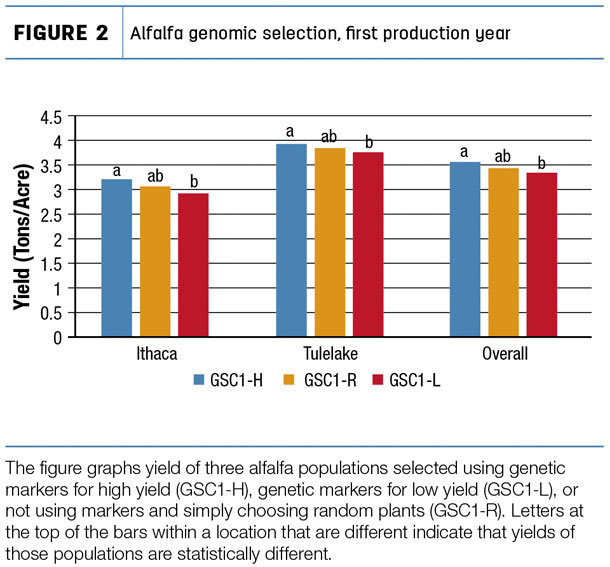Forage breeders would like all the seeds in a bag to be just like the children of Lake Wobegon – above-average. But it’s not simple and, frankly, since the number of plant breeders working across all forage crops pales in comparison to the major crops, progress can be slower than the major crops and the fruits of new technologies less apparent.
I want to discuss some research we are pursuing to use genetic markers to improve yield (and other traits). We’ve been talking about the revolution created by molecular genetic markers to map genes for a long time. In fact, way back in 1993, I published a scientific paper describing the first alfalfa genetic map. But use of these technologies to develop better forages has not really occurred … yet. This technology is distinct from transgenic cultivars (i.e., genetically modified organisms or GMOs).
What are genetic markers? Simply put, a genetic marker represents a difference in the DNA sequence between two plants. All DNA – whether in humans, cattle or alfalfa – is composed of four nucleotides (bases) represented by the letters A, G, C and T.
These bases are joined together into long DNA chains that reside on chromosomes in every cell. Collectively, all the DNA of an organism is called its “genome.” Imagine that one plant has a DNA sequence of GGCAA at a particular place in its genome, and a second plant has a sequence of GGTAA at this location. The marker in this case is represented by either a “C” allele or a “T” allele.
Now, perhaps this marker is associated with plant height so that plants with “C” might be tall and those with “T” might be short. Once markers are associated with traits, breeders can use them to select plants without actually measuring the trait. Because a plant’s DNA is the same whether it’s a seedling or a 5-year-old plant, selection based on a marker can be done very quickly without having to measure plant height (or any other trait) in the field. So far, however, relatively few traits have been associated with markers in most forage crops, although this work is continuing. The population nature of forage cultivars and the relatively small number of breeders has limited greater use of markers to date.
The trait I’m most interested in is yield. In the U.S., the yield potential of new cultivars seems to have hit a plateau. Sure, yields of newer varieties with better disease or insect resistance tend to be better than older varieties susceptible to these pests and diseases. But in the absence of disease or insect pressure, overall yield has not gone up much, if at all. I’ve been interested in trying a breeding method called “genomic selection” to address yield gain.
Here’s the gist of what we want to do. Maybe you’re playing Hold ’Em with your friends (well, I prefer Omaha Hi-Lo, but that’s another story), and you notice that your buddy will start rubbing his ear when he has a good hand. You start collecting data: Your buddy rubs his ear, he then plays a winning card, and you lose. If it happens a couple of times, maybe you don’t think anything about it – but after a while, you realize you can predict what’s going to happen and so, when he rubs his ear, you fold and don’t contribute more to his kid’s college fund.
We are doing exactly the same thing with genomic selection. We are looking for a relationship between the genetic markers that a plant has and its yield. There’s not a single “yield gene,” so we need to look at thousands of genetic markers throughout the entire genome.
But when we do that, we can correlate the presence of various markers with high yield (or low yield, for that matter) or with other traits. First, we gather data: What marker alleles do plants have, and how does each marker affect yield? Then we make predictions: If plants have a particular set of markers, they should have high yield, just like your buddy rubbing his ear shows you he has a good hand.
Why not just measure yield in the first place? Well, here is where the marker-based selection has serious potential for forages. Measuring yield is difficult because multiple harvests across multiple years for any given plant or plot takes a lot of time, and the number of plants or plots you can measure is consequently limited. With markers, you could conceivably evaluate many more plants as seedlings using only markers in order to predict yield. If the relationship between markers and yield is good, then about every six months (maybe less) a breeder could turn a cycle of selection. So faster selection equals more yield gain – in theory.
We tested this theory. Together with colleagues at Cornell University, we measured yield on several hundred plants and also assayed thousands of genetic markers on the same plants. Then we developed a model relating marker profiles to yield. The model’s not great, but it’s good enough for a first test. We then evaluated hundreds of new plants using only genetic markers. Based on our model, we predicted the 20 plants we expected to have the highest yield and the 20 we expected to have the lowest yield. As a control group, we simply identified a random set of 20 plants.
We took the 20 plants from each group, crossed them together and then produced enough seed of each one so that we could plant small-plot yield trials. We conducted trials in Ithaca, New York, and Tulelake, California (Figure 1). 
The results, shown in Figure 2, demonstrate that genomic selection has potential: The population selected for high yield produced more than the one selected for low yield, and the control “random” population fell in between, exactly as expected.

More work remains, but this initial proof of concept shows that genetic markers have the potential to improve even complex traits like yield. It’s an exciting development; I’m going all in. ![]()
Charlie Brummer is a alfalfa and forage crop breeder at the University of California – Davis. Email Charlie Brummer.









